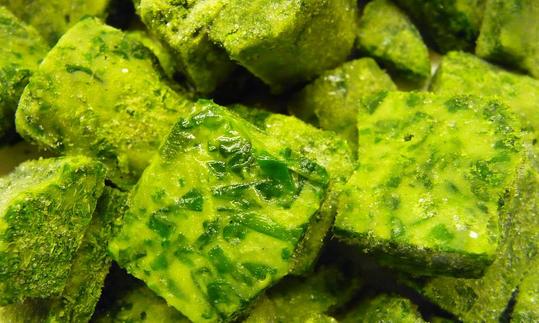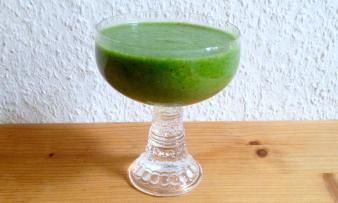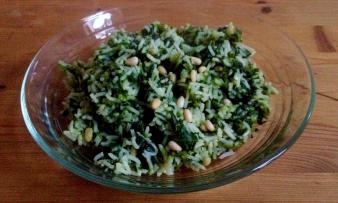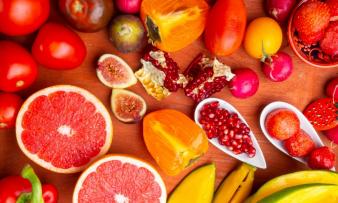Spinach (also called true spinach, vegetable spinach or garden spinach) is a very tasty leafy vegetable. Freezing extends its shelf life enormously.
Use in the kitchen:
Frozen spinach is usually blanched, chopped and shock- frozen, unprepared spinach leaves. 1 Blanching softens the slightly metallic, bitter and astringent taste of the spinach and reduces the nitrate content. The water-soluble nitrate remains in the cooking water. Unfortunately, important ingredients are also lost.
In frozen form, spinach is versatile and can be used quickly: it can be used as a vegetable side dish or as a vegetable ingredient in pasta, rice, casseroles or quiche. Pureed into a thick soup, it is served with potatoes (and eggs) in traditional German cuisine. Stews and curries can also be refined with a spinach topping. Many green smoothies are refined with spinach. You can find a recipe with an exotic flavor here.
| Not only vegans or vegetarians should read this: Vegans often eat unhealthily. Avoidable nutritional errors. |
Shopping:
Frozen leaf spinach is available in every supermarket. If possible, look for organically produced vegetable spinach. Spinach is in season in the western regions of Europe between February and May. When grown in greenhouses, real spinach can also be found from domestic production until November (D, A, CH).
Found in the wild:
Green (Good) Henry ( Blitum bonus-henricus, syn.: Chenopodium bonus-henricus) is still known today as wild spinach. Like garden spinach, it is also a member of the Amaranth family. It can be found throughout Central Europe and in eastern North America. It has many uses: the young, not yet flowering leaves are suitable for spinach, the shoots, which are around 12 cm long, can be used as asparagus. The flowers are steamed like broccoli. In the Balkans, the crushed rhizomes (roots) are used to make candy that resembles peanut butter. 2
Homemade preparation:
It is best to pick and wash fresh spinach without squeezing or spinning it. Simply dry it with a cloth. After that, we recommend briefly blanching it, cooling it in ice water and then freezing it.
Storage:
Frozen spinach can be stored for up to 10 months.
Ingredients:
Spinach contains vitamins such as pro-vitamin A, vitamin C, E and K. It can therefore support the eyes and the immune system. Spinach contains iron, but not in as high quantities as originally thought. However, even after the correction to 2.71 mg/100g, spinach still contains more iron than almost any other vegetable. 500 g practically cover the daily iron requirement. Peas and beans contain almost twice as much iron or more, as do wild vegetables, spices, dried foods, etc., but these are consumed in small quantities. 4 Garden spinach also surpasses meat and the high vitamin C content increases absorption. 5
Other minerals such as manganese, magnesium and folate (folic acid) characterize spinach. Compared to many other leafy vegetables, real spinach is rich in plant proteins, with 2.3% 4 to 2.86% 5. Spinach is probably the most nutritious leafy vegetable known, although it only has 22 calories per 100 g. 5 Values: 100 g of spinach contains 194 µg, almost the daily requirement (200 µg) of folate as a folic acid-active substance group, and about half the daily requirement of vitamin A (retinol equivalent), namely 469 to 672 µg of 1000 µg. 5 See the ingredient tables (nutrient tables) as a link above or open below this text.
Health aspects:
The antioxidants contained in spinach are said to have a cancer-preventing effect. The provitamin A (beta-carotene) in spinach and the carotenoid lutein have a positive effect on the eyes 8. A comprehensive study by the Massachusetts Eye and Ear Infirmary and Harvard University (USA) has shown that 55- to 80-year-olds who regularly eat spinach are much less likely to suffer from a loss of vision due to degenerative changes in the retina than their peers. 4 Fresh leaf spinach juice is extremely effective against anemia and is highly recommended for all athletes and young people of growing age. Half a glass a day ensures optimal effects. 4
Dangers/Intolerances:
Raw spinach contains oxalic acid, the amount of which depends on the age of the leaf, among other things. Young leaves contain less oxalate. Oxalic acid, which breaks down into water, carbon monoxide and carbon dioxide when heated to over 150 ºC, can be harmful to health. Certain minerals such as calcium form complexes that are difficult to dissolve when they come into contact with oxalic acid, making it difficult for them to be absorbed through the intestines. Oxalic acid also attacks tooth enamel and, in large quantities, contributes to the formation of kidney stones. Nevertheless, eating foods containing oxalic acid in reasonable amounts does not pose a threat. As a comparison: according to Wikipedia, the lethal dose of orally ingested oxalate is 600 mg per kg of body weight, which corresponds to around 4.5 kg of raw spinach for a 60 kg person. The disadvantages only start to outweigh the advantages at one kg, but who eats that anyway...
If too much nitrogen is used, which is particularly common in greenhouses, spinach accumulates nitrate. If the nitrate is converted to nitrite, this impairs the transport of oxygen in the body. This is particularly dangerous for children. If cooked spinach is reheated or kept warm for a long time, the nitrite present can form carcinogenic nitrosamines.
Folk medicine:
Spinach leaves were originally used as a remedy for flatulence, as a fever reducer and for inflammation of the lungs and intestines. The seeds served as a laxative, but also helped with respiratory problems, liver inflammation and jaundice. Spinach is also said to help with loss of appetite and tiredness. The hypoglycemic properties of real spinach are also mentioned in popular wisdom. 9
Occurrence:
The origin of spinach is not clear. It is believed to have originated in Southwest Asia from the wild spinach species Spinacia tetrandra Stefen ex M.Bieb. and Spinacia turkestanica. A precursor to our modern spinach was cultivated in Persia as ispanāğ. The Arabs brought it to Spain as isbanāh, where it was first mentioned as espinaca in the 9th century. Spinach did not reach Central Europe until the 13th century. Today, spinach is cultivated as a vegetable plant in temperate zones around the world. 3
Cultivation, harvest:
The annual herbaceous plant has upright, yellowish to pale green stems and reaches a height of 50 to 100 cm. At first the leaves are arranged in a rosette, later alternately on the stem. Spinach tastes best when it is as young as possible. When the plant forms flowers and later seeds, the leaves are no longer as fine and tender. The plants are very susceptible to caterpillars, leaf miners, lice and bugs. Molds such as Cladosporium and mildew are also common. When growing, make sure to keep the plants far apart and check regularly for pests.
Spinach plants only need short day conditions. Plants sown in August can be harvested in late autumn and winter. If harvested in spring, sow in September or in open ground from mid-March. In the event of severe frost, the spinach plants should be covered. High nitrogen fertilization (including manure) promotes nitrate accumulation in the spinach plants.
General information:
Spinach ( Spinacia oleracea) belongs to the Amaranthaceae family, more precisely to the Chenopodiaceae subfamily. The genus ( Spinacia ) also includes two other species: Spinacia tetrandra is found in the Caucasus and Western Asia and Spinacia turkestanica is widespread in Central Asia and India.
The main producing countries worldwide are China, the USA, Japan and Turkey. In Europe, spinach is mainly grown in Italy, France and Germany. Due to its short shelf life, most of the spinach harvest is sold as a frozen product.
In addition to being used as a direct food, spinach is also used as a coloring agent for foods such as pasta. The chlorophyll from the spinach mat contained in the leaves serves as a green food coloring. This chlorophyll is also added to mouthwash and serves as a neutralizer for odor-producing products.
The original misconception that spinach contains excessive amounts of iron is based on two different assumptions. In 1890, the Swiss scientist Gustav von Bunge correctly calculated that 100 g of dried spinach contained 35 mg of iron. These figures were incorrectly applied to fresh spinach, which only contains about a tenth of the iron. 6 The second assumption is based on an accidentally misplaced decimal point, but this has never been proven. 7
Literature / Sources:
- 5amtag.ch /news /tiefkuhlspinat-healthier-than-you-think/
- Wikipedia: Good Henry
- Wikipedia. Spinach.
- USDA: US Food Database.
- Pamplona Roger JD Healing powers of food. Zurich: Advent-Verlag; 2006:36
- Sutton M. Spinach, Iron, and Popeye: Ironic lessons from biochemistry and history on the importance of healthy eating, healthy skepticism and adequate citation. Internet Journal of Criminology. 2010.
- Hamblin TJ. Spinach - I was right for the wrong reason. Mutated Unmutatex Blogspot. 2010;12.
- pro-retina.de /research-funding/ scientific-advisory-committees/ recommendations/lutein-and-zeaxanthin
- abcde Spinacia oleracea at Plants For A Future










Comments